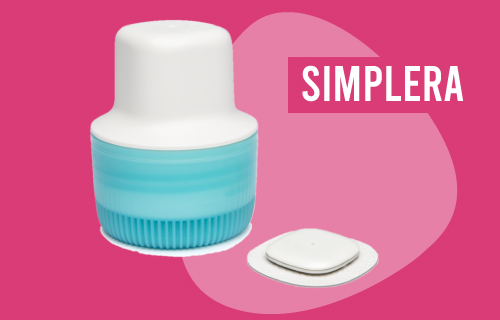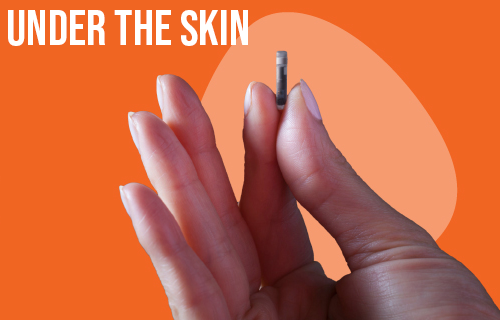
Eversense’s new epic 365 days sensor!
Senseonics have worked for a number of years to develop a groundbreaking new way to measure blood glucose with their Eversense sensor technology. It has the potential to outperform any existing blood glucose sensor on the market in terms of durability and their latest Eversense 365 days sensor is doing exactly that.
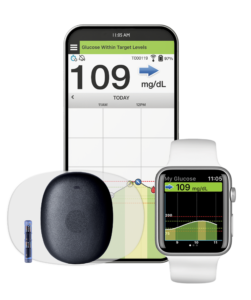
With its staggering 365 days of use, the Eversense 365 CGM is working 35 times longer than the latest G7 10.5 days sensor from Dexcom and 24 times longer than the 15 days Freestyle Libre Plus sensor from Abbott, which are the two leading sensor brands in the market.
To realize such extremely long sensor durability, Senseonics have developed a new methodology by how blood glucose can be measured while also matching other key performance criteria that are offered by other sensor brands in the market. It also avoids most false alerts; it is very small while also being very accurate. We will describe all key features of this new Eversense 365 CGM sensor below and highlight where it really stands out versus other sensors.
The Eversense 365 CGM sensor
Let’s first take a closer look at the Eversense 365 sensor itself. It is very small, just 18 mm long and 3.5 mm in diameter. The sensor is inserted under your skin by your doctor, by making a small 5-7mm long incision on the skin using local anaesthesia. It is a small quick procedure, taking just 8-12 minutes and typically closed up by using a few lines of e.g. Steri-strips. It then stays working there for the next 12 months and many patients choose to use the same location when replacing it with their next sensor 12 months later if not changing to the other arm.
The sensor uses a special fluorescent chemical coating on the outside, generating a small amount of light based on the glucose concentration in the surrounding interstitial fluids it is placed in. The sensor is powered via induction from the Transmitter, which is placed on the skin just above the sensor. It is the Transmitter that picks up the blood glucose readings every 5 minutes from the sensor and then also sends this on to your smartphone via Bluetooth. The app on your smartphone is then able to show you your instant blood glucose values and also various statistics and reports on this.
It is also worth noticing that the Eversense 365 sensor itself has been approved for different medical imaging procedures like CT- and MRI scans. Here you just remove the Transmitter while the sensor itself can remain under your skin. After the procedure is completed, you just put the Transmitter back and the system will be back working again as before. So no waste or need to insert a new sensor, as is the case with alternative blood glucose sensors.


The Eversense 365 Transmitter
The next special part of the Eversense system is the detachable Transmitter which sits on the arm just above the implanted sensor. While the sensor itself is placed under the skin making the glucose readings from the interstitial fluid the Transmitter both powers the sensor and wirelessly sends all the glucose readings to an app on your smartphone every 5 minutes. This is done via Bluetooth and your smartphone needs to be within around 25 feet of distance for this to work. The Eversense system works with both Apple iOS and Android phones. There are several more unique functions of how the Eversense Transmitter works and what functions it supports the user with that are not seen in any other blood glucose sensors in the market.
The Transmitter itself is well designed in a soft smooth curved surface when placed on the arm. So it does not easily catch your clothing or get ripped against a doorframe when you walk around your home like some other BG sensors on the market does. It is also water resistant so you can shower with it or go for a swim with it. But it also offers the option to take it off and place it back on again minutes later if you prefer.
While the sensor itself is tiny, the Transmitter is quite large in its size and height. Comparable in size to the Dexcom G6 model, though more gently rounded in its shape. When compared to Freestyle Libre 2 and 3 and also to the latest Dexcom G7 sensor, then the Eversense Transmitter is quite bigger and bulky in comparison. But the Eversense Transmitter also offer more functionality in comparison. You can get glucose alerts directly from the Transmitter as it can both vibrate on your skin and buzz when your blood glucose is going either too high or too low. This is not something other blood glucose sensors in the market can do, where you always need your phone or special Reader to get such alarms. These are then remote devices that you do not necessarily hear like if you sleep or if you leave your phone a bit far away. So the Eversense Transmitter alarms are both direct and more discreet than anything else we have seen in the market before. Such a more direct and discrete alarm is something potentially also better for e.g. your work environment or for your spouse at home not to be waking up the whole family when you get any alarms. Similarly, it also allows you more freedom and independence from your phone when doing sports or other exercises, so you are not relying on always having to bring your phone along with you.
Additional really smart features with the Transmitter alarms are that you can directly on the Transmitter press a little button to snooze the alarms if you want and it also offers different vibration/buzzer patterns to indicate if the alarm is for going too high- or if going too low in blood glucose. So again, you get this information without you need your phone to understand the reason for your alarm.
The Eversense Transmitter is attached to your skin by using a special double-sided silicon patch, which is offered in transparent or in white colour. You cannot freely choose where to put the Transmitter as it needs to be placed reasonably right on top of your implanted sensor, for it to ensure proper communication with the sensor below in the skin. But the Transmitter can be taken off your arm for shorter durations and then placed back on again without you needing new adherence. On your phone, you can see a test screen showing the strength of the sensor signal with the Transmitter, which serves as guidance to you for placing the Transmitter best possible on your arm. The Transmitter will also start to beep if you remove it from your sensor on your arm, so typically you will switch your Transmitter off if doing so.
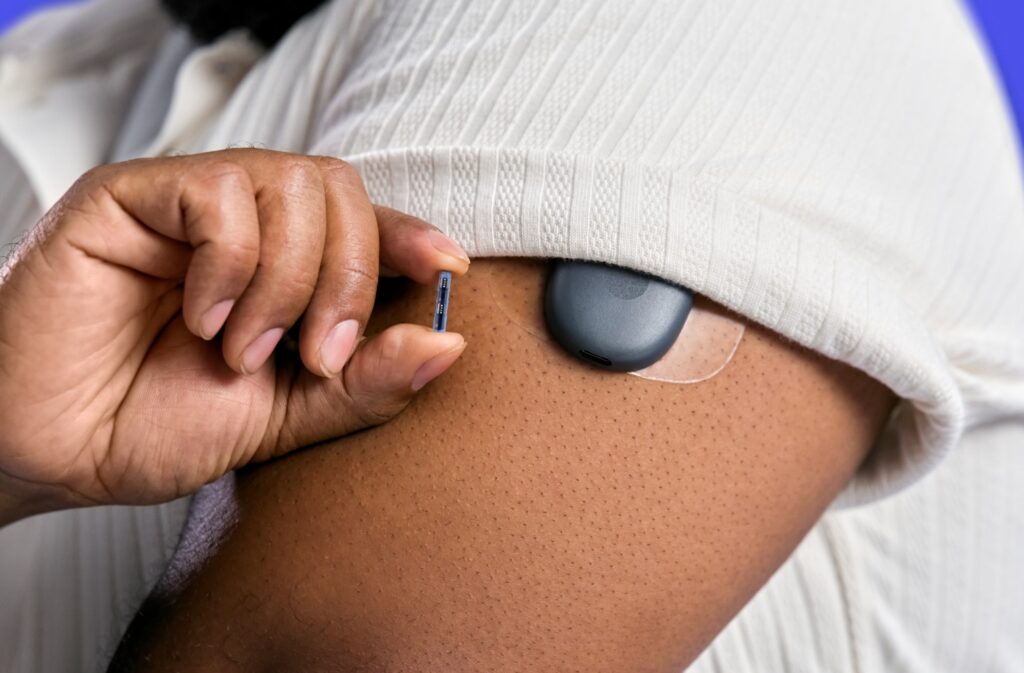
Charging & battery life of the Eversense Transmitter
Though it may come in handy that you can take on and off the Transmitter more freely versus competing blood glucose sensor brands, then it is also a requirement to do so, as you need typically to charge the Transmitter minimum every 36-28 hours of use. So most users will typically do this on a daily basis. The Transmitter will start to issue audio alarms when the battery is going below 10% capacity remaining and it takes just about 15 minutes to charge it fully up from empty. So this charging routine can also fit well with e.g. when you take your morning shower.
So though the Eversense 365 system lasts for a full year and you will not need to bring along spare sensors with you wherever you go somewhere for work or vacation, then you will typically need to bring the Transmitter charger with you, if gone from home for more than 1 day. It is through using a standard micro-B USB connector for charging, so you may also be able to find an alternative if you forgot the charger at home.
Accuracy of the Eversense 365 CGM
One of the most important aspects of a blood glucose sensor for most users is it’s level of accuracy and that it performs reliably with this over time. From the official clinical studies and data submitted to the regulatory authorities to approve blood glucose sensors for the market, then we know the Eversense 365 CGM has a mean absolute relative difference (MARD) score of 8.8%. Best alternative sensors in the market like Dexcom G7 has a MARD of 8.2% and the Abbott Freestyle Libre3 has a MARD of 7.9% (smaller is better).
So all of these are performing very well in this aspect. For daily practical life, then any sensor having a MARD around 10% or better will typically be sufficiently accurate to support good glycaemic control.
Reliability from the sensor is another aspect that is important to most users and here the Eversense 365 is also having great performance. It is sitting under the skin and therefore also less exposed to pressure lows, which is a well-known trouble area for the traditional CGMs that are placed on top of our skin. If laying down to sleep or sideways in a chair causing pressure on the sensor, it can suddenly start to report too low blood glucose numbers, as the normal vascular perfusion of the skin where the sensor sits is getting hindered.
As the Eversense 365 is working for a full year, then it is also more reliable versus traditional CGMs in this aspect as it will only have to go through 1 warmup phase for a full year of usage. While the traditional CGMs typically have 30-60 minutes of warmup followed by 6-24 hours the first day, where they are less accurate for every time you start a new one up of these every 10-15 days. Another reason the Eversense 365 has been reporting a generally very good level of accuracy over its full lifetime of 365 days is no doubt also related to the weekly schedule of performing a calibration of it, which we will cover in the chapter below.
Eversense 365 sensor insertion
When first hearing that the Eversense 365 sensor needs to be inserted under your skin by your doctor performing a small incision, then many potential users will be reluctant. But it is in reality a very small and easy procedure to go through. Much actually the same which is also used by many women these days using the 3-year-lasting contraceptive implant (birth control implant) of a small plastic rod. Very much the same type of quick minimal invasive procedure and also in your upper arm by using a local anaesthetic on your skin.
Your doctor will use a pen to mark on your arm where you ideally want your sensor to sit. Then the doctor will use a template that comes with the sensor as overlay to mark where the small incision should be made to match this. A local skin anaesthetic is administered and then he makes the few millimetres long cut, which enables the sensor insertion. The cut is typically just 5-6 mm long and does therefore not require any stitches to be made afterwards. The little cut is closed up with 3-4 Steri-strips set across. The whole procedure from start to completion is typically done in 10-15 minutes.
Worth noticing that it is not advisable to take a bath or go swimming for the first 5 days after sensor insertion. A quick daily shower is OK, but it is best to keep the wound as dry as possible until the healing is closing up the skin. It is a small cut, so typically healing up fast and after 14 days or so the incision is hardly visible anymore. But it’s worth keeping in mind if e.g. planning a beach vacation around the time of a new sensor implant.
After the sensor insertion then the Eversense 365 CGM goes through a 24-hour warmup period in which you will not get any blood glucose readings from it. You can therefore spend this time instead to download the apps offered by Senseonics for tracking and reporting your glucose values and also connect with and get familiar with the Transmitter device itself and the app you use for it.
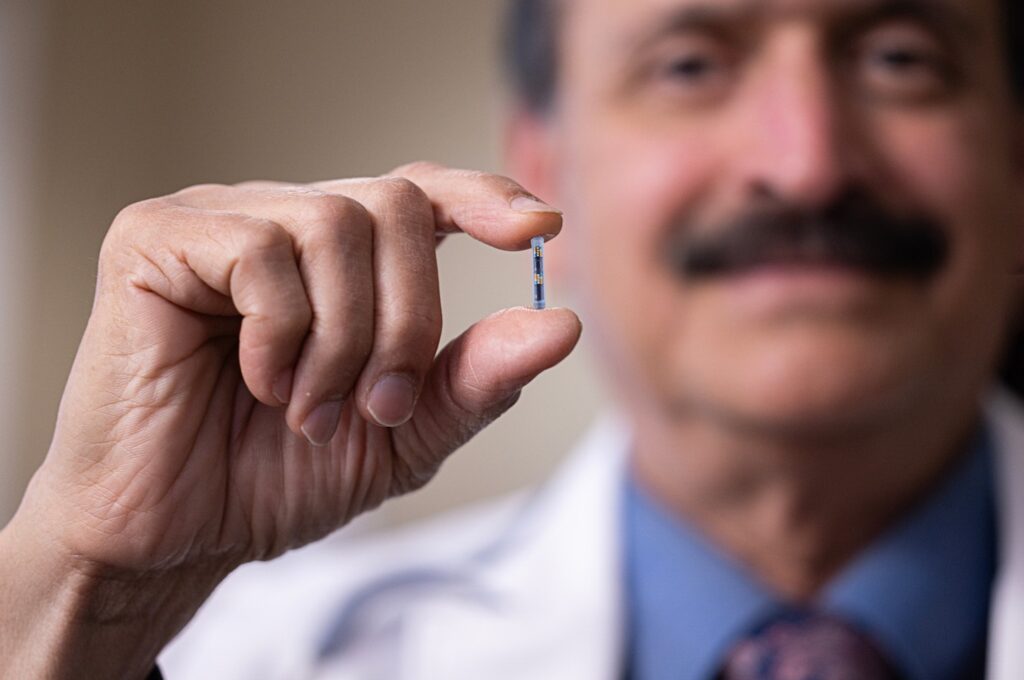
Eversense 365 sensor calibration
24 hours after the sensor insertion it is now time to put on the Transmitter and prepare for the first calibration routine to be performed. This comes 10 minutes after you start your Transmitter and will be the first of 3 phases of calibrations you will go through.
Phase 1 calibrations: Initialization phase
After the 24-hour warm-up phase, you must complete 4 fingerstick calibrations, spaced 2-12 hours apart. These 4 calibrations must be completed within a 36-hour period.
Phase 2 calibrations: 1 daily calibration phase
After the initial phase you will now only need to conduct 1 daily calibration for the next 13 days.
Phase 3 calibrations: 1 weekly calibration phase
From 2 weeks after inserting the sensor you will now only be asked to do one calibration per week going forward. This ensures that your Eversense 365 CGM stays very accurate for its entire lifetime of one year.
The Eversense 365 phone app
As your sensor has completed the warm-up period and the Transmitter has been switched on, you can now start to use the Eversense application on your phone. It is nothing especially fancy and looks a bit rustic in its design but it gets the job done. Your latest blood glucose reading is shown with large easy-to-read numbers on top and an arrow to indicate the trend of where it is heading. Next, you have a graph showing your blood glucose values over time, where you can easily scroll and zoom in and out. And for those that like to keep track of more details related to their glucose management, then you can also tap on the graph to add notes regarding any events you like, e.g. if taking insulin, doing sports or maybe having a meal or snack.
On the graph, you can also see the threshold ranges set up for the too high- and too low glucose alarms. A very helpful alarm feature with the Eversense 365 app is that you can also set up your custom-defined predictive alarms that will alert you at a certain time before you are predicted to reach a set high- or low blood glucose level. This pre-warning time can be set to 10, 20 or 30 minutes, so you have this timeframe to react in before your blood glucose level may reach the set alarm level. Another very helpful alarm function is alerts if your blood glucose level suddenly starts to change rapidly over a short time. This can be very helpful in the situation where you have eaten something but forgot to take some insulin to counteract it. Or the opposite situation where you maybe of anticipation of a larger carb meal had pre-bolused with fast-acting insulin, but then actually got distracted from your meal and/or you may not have gotten the number of carbs as you had anticipated.
With the Eversense 365 app, you also have the option to share your blood glucose data in real-time with 5 other family members, partners or relevant caregivers. Senseonics also offer more data reporting and insights available through uploading your data to Apple Health and an online reporting system called DMS. DMS is a rather advanced reporting system, that offers a wealth of interesting data analytics and graphs, which can help you with insights to further improve your glucose management.
Eversense 365 availability and cost
The Eversense 365 CGM was approved by the US FDA back in September 2024 and the number of new users being implanted with it has started to pick up from the start of 2025. Senseonics filed on February 6th 2025 also for CE mark registration to access the European market, where there is a similar market size. The precursor sensor model Eversense G3 lasting 180 days was approved back in June 2022 and implanted with good results in patients in Germany, Italy, Spain, Sweden, Poland and Switzerland. So, the further improved 365-day sensor model is expected to go through the approval process with minimal hurdles or delays.
With regards to the price for Eversense 365, it appears as a base to being aligned with similar costs for alternative classic sensors and what they cost over a full year of use. But depending on your location and personal health insurance plan the Eversense 365 may come out to be cheaper for you overall.
The cost without any insurance coverage is around US$ 3,500 for the equipment and the implant procedure with the doctor.
While with e.g. United Healthcare, you pay US$199 for the Eversene 365 sensor and transmitter. While the insertion procedure costs around US$ 250, you may have to pay US$ 25 if having the 10% co-insurance plan with them.
With Medicare/Blue Cross prices may be as low as US$ 74 or up depending on your insurance policy. Like US$ 240 in co-pay for the insertion and US$ 60 for the actual equipment. So about US$ 300 in total. Much comparable to what you typically would have to pay out of pocket for just 12-15 weeks of coverage when using the traditional sensors from Dexcom or Abbott.
Senseonics has a good website for potential users, where they can assist you with locating an experienced sensor implanter near your residence and can also help you navigate your options for cost coverage through various insurance plans.
Comparing Eversense 365 with Dexcom G7
Key performance criteria comparing the two BG sensor systems side by side:
Glucose Sensor | Eversense 365 | Dexcom G7 |
|---|---|---|
Sensor lifespan | 365 days | 10.5 days |
Time between readings | 5 minutes | 5 minutes |
Warm-up period | 24 hours | 30 minutes |
Accuracy [MARD] | 8.8% | 8.2% |
Alarms | Yes, including vibration on the skin without using the phone | Yes but relying on the phone |
Prone to pressure lows | No | Yes |
Sensor lost in case of rip-off | No, the Transmitter can be reapplied again | Yes, a new sensor is required |
Calibration | First week 1/day | As required |
Sensor application | At the doctor once per year | At home, every 10 days |
Charging | 5-10 mins per day for the Transmitter | Not needed |
Smartphone app | Yes | Yes |
Smartwatch app | Yes | Yes, with the Apple watch |
Who can use it | 18 years and older | 2 years and older |
Insulin pump integration | Yes | Yes |
CT- and MRI approved | Yes | No |
Sensor placement | Upper arm | Upper arm |
Size | Sensor length 18.3mm, diameter 3.5mm. | 24x27mm, 4.6mm thick |
Data source: Respective user guides for Dexcom G7 and Eversense 365.
20+ years healthcare industry professional
40+ years diabetic type 1.
https://www.linkedin.com/in/renestistrup/
- Eversense 365 media kit:
https://www.ascensia.com/media/ Eversense365-media-kit/ - Eversense 365 user guide library:
https://www.eversensecgm.com/user-guides/ - Eversense 365 user guide:
https://www.eversensediabetes.com/wp-content/uploads/LBL-7702-01-001_Rev_D_Eversense_365_User_Guide_mgdL_R2_web.pdf - Dexcom G7 sensor user guide:
https://dexcompdf.s3.us-west-2.amazonaws.com/en-us/G7-CGM-Users-Guide.pdf - Abbott Freestyle Libre 3 sensor user guide: https://freestyleserver.com/payloads/ifu/2023/q3/ART41641-001_rev-A-web.pdf
- Eversense 365 receives FDA approval Septemver 17th 2024:
https://www.senseonics.com/investor-relations/news-releases/2024/09-17-2024-120118174 - Senseonics completes CE mark submission February 6th 2026:
https://www.senseonics.com/investor-relations/news-releases/2025/02-06-2025-210527139
Graphic files used:
Fig 1: Eversense 365 on arm.jpg – Acensia Eversense media kit.
Fig 2: Eversense product suite w phone app and watch.jpg – Ascensia Eversense media kit.
Fig 3: Eversense sensor 365 closeup.jpg – Ascensia Eversense media kit.
Fig 4: Eversense 365 in fingers.jpg – Ascensia Eversense media kit

© Not Just a Patch 2023. Proudly created by AudsleyDesigns

